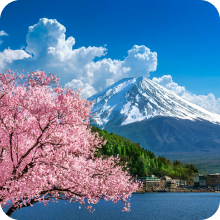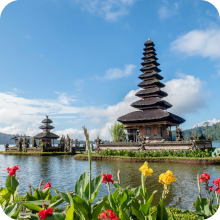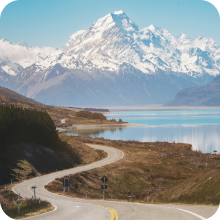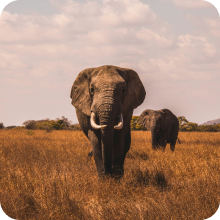Understanding the Scale: How Big is Australia Compared to the USA?
Table of Contents
Welcome to our exploration of the vast landscapes of Australia and the United States. As travelers and geography enthusiasts, we often find ourselves comparing the size of different countries. Today, we delve into a fascinating comparison: How big is Australia compared to the USA?
In our quest to understand the world better, it's not just the 'where' that intrigues us, but also the 'how much' – especially when it comes to the sheer scale of the lands we dream to traverse. Let's embark on this journey of comparison, shall we?
Geographical Comparison of Australia and the USA
When we talk about size, it's all about perspective. Australia, the world's smallest continent yet the largest island, boasts an impressive land area of about 7.692 million square kilometers. Now, hold your hats, because when we swing the spotlight over to the USA, it expands over approximately 9.834 million square kilometers. That's like comparing a whale shark to a slightly bigger whale shark – both are astounding in their own rights!
Australia's Vast Landscape
The land down under, Australia, is a cornucopia of natural wonders. From the sunbaked Outback to the lush rainforests of Queensland and the iconic Great Barrier Reef, Australia is a textbook example of diversity. But here's a fun fact: despite its vast land area, much of Australia's terrain remains uninhabited, with a majority of Aussies choosing to live along the coast. Surf’s up for most Australians, it seems!
The Diverse Terrain of the USA
In contrast, the USA is like a grand patchwork quilt of landscapes. With 50 states each boasting its own unique geographical fingerprint, the country is a kaleidoscope of deserts, mountains, plains, and beaches. Think about the arid Death Valley, the majestic Rocky Mountains, the sprawling Great Plains, and the sun-kissed beaches of California. It's like Mother Nature used the USA as a canvas to showcase her best work.
Population Distribution and Density
Now, let's talk about the people. Australia, despite its colossal size, is sparsely populated with around 25 million souls calling it home. This figure is dwarfed by the USA’s staggering population of over 330 million. It's like comparing a bustling metropolis to a serene small town - both have their charms, but the scale is vastly different.
Australia's Population Centers
Australia's population is like glitter sprinkled along the coastline – sparkling, concentrated, and vibrant. Cities like Sydney, Melbourne, and Brisbane are bustling hubs of culture and activity. However, venture inland, and you'll find the "Outback" – vast, arid, and sparsely populated. It's a land where kangaroos outnumber people and the horizon stretches endlessly.
Population Dynamics in the USA
The USA, in contrast, is a melting pot of diversity, with its population spread more evenly across its vast land. From the densely populated urban jungles of New York City to the quiet, rolling hills of the Midwest, each region has its own unique demographic tapestry. The USA is like a grand social experiment with every state contributing its own flavor to the mix.
Climatic Variations Across Two Continents
When it comes to climate, both Australia and the USA pack some surprises. The climates in these countries are as varied as their landscapes.
Australia swings from tropical in the north to temperate in the south, with a generous slice of desert in between. It’s a place where you can experience the humidity of the Tropics and the chill of the Southern Alps.
The USA, meanwhile, is a climatic smorgasbord. Fancy the sun? California and Florida await. Love the snow? Hello, Alaska and Colorado! Prefer a bit of everything? The Midwestern states offer a buffet of seasonal changes. The sheer variety is like a weather enthusiast’s dream.
Travel Implications
Given the vastness of both countries, travel here is an adventure of epic proportions. But the size impacts travel experiences in uniquely different ways.
Road Trips and Distances
In Australia, road trips can mean long drives through arid landscapes with occasional kangaroo sightings. The famous Great Ocean Road or the journey to Uluru are adventures of a lifetime but require preparation for long distances.
In the USA, road trips are like chapters in a storybook, with each state offering a new narrative. Route 66, the Pacific Coast Highway - these aren't just roads; they’re journeys through the heart and soul of America.
Thanks for visiting our blog, are you planing to travel to the US? Check out our USA SIM card or our eSIM USA before you take off.
Diversity of Attractions
Both countries are treasure troves of attractions. In Australia, it’s about the unique wildlife, pristine beaches, and the rugged Outback. The USA counters with iconic landmarks like the Grand Canyon, the Statue of Liberty, and Hollywood, plus natural wonders and bustling cities.

Economic and Environmental Perspectives
The size of a country can have profound impacts on its economy and environment. Australia, with its wealth of natural resources, faces challenges in balancing economic growth with environmental preservation. The USA, as a global economic powerhouse, grapples with similar issues on a larger scale, striving to maintain its economic might while addressing environmental concerns.
Economic and Environmental Perspectives
Now, let's shift our lens to the economic and environmental aspects, shedding light on how the size of these countries influences their policies and challenges.
Economies in the Limelight
Australia boasts a strong and resilient economy, primarily driven by industries like mining, agriculture, and services. Its abundant natural resources, including coal, iron ore, and gold, play a crucial role in the global market. The size of the country enables it to be a major player in resource exports, contributing significantly to its GDP.
The USA, on the other hand, is the world's largest economy, fueled by a diverse range of sectors including technology, finance, healthcare, and entertainment. The country's sheer size, coupled with innovation and entrepreneurship, makes it a global economic powerhouse. Hollywood, Silicon Valley, and Wall Street are just a few of the names that resonate globally.
Environmental Challenges and Conservation Efforts
With great size comes great environmental responsibility. Australia grapples with unique environmental challenges, including droughts, bushfires, and conservation of its diverse wildlife. The vastness of its wilderness areas requires concerted efforts to protect fragile ecosystems and endangered species like the koala and Tasmanian devil.
In the USA, size also brings forth a range of environmental concerns. Climate change, air and water pollution, and preservation of natural wonders like the Everglades and Yellowstone are high on the agenda. The country's diverse landscapes demand thoughtful conservation policies and responsible stewardship.
As we wrap up our exploration of the economic and environmental perspectives, it's clear that both Australia and the USA face their share of challenges and opportunities. Now, let's conclude our journey with some final thoughts on the significance of understanding the geographical scale for travelers.
In the grand tapestry of our world, Australia and the USA stand as colossal chapters, each with its own unique story. As travelers, understanding the sheer scale of these nations enriches our adventures. It's not just about where we go, but how we comprehend the vastness of our planet.
Australia, with its wide-open spaces and vibrant cities, invites us to explore its natural wonders and rich culture. The USA, with its diverse landscapes and bustling metropolises, offers an array of experiences to suit every taste. Before you take off make sure to check with local government of the travel status.
So, when you plan your next journey, remember that size does matter – not in terms of bragging rights, but in the depth of experiences awaiting you. Whether you're gazing at the stars in the Australian Outback or standing in the neon glow of Times Square, these colossal lands have stories to tell, and they're waiting for you to listen.
FAQ
Is Australia bigger than the USA?
Yes, Australia is slightly smaller in land area compared to the USA.
How does the population of Australia compare to the USA?
Australia has a significantly smaller population than the USA.
What are the major climatic differences between Australia and the USA?
Australia has diverse climates, including tropical, arid, and temperate regions, while the USA experiences a wide range of climates, from tropical to arctic.
Are there similar travel experiences in Australia and the USA?
Both countries offer unique and diverse travel experiences, catering to various interests and preferences.
How does the size of Australia and the USA impact their economies?
The size influences their economic strengths, with Australia excelling in resource exports and the USA as a global economic powerhouse.









